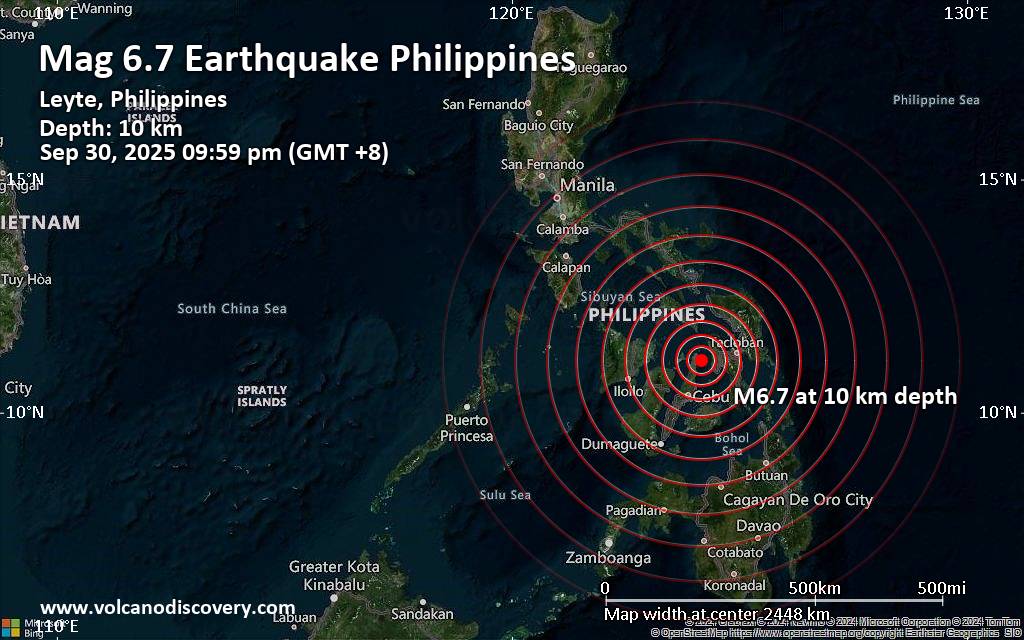Here’s a detailed article about the recent earthquake in the Philippines — especially around Cebu / Central Visayas — its tectonic background, immediate impacts, and broader context.
🇵🇭 Earthquake in the Philippines: Cebu & Central Visayas, 2025
What Happened
-
On 30 September 2025 at 21:59:43 Philippine Standard Time (UTC+8), a magnitude 6.9 earthquake struck in the central Philippines.
-
The epicenter was located in Cebu Province, in the Central Visayas region.
-
The Philippine Institute of Volcanology and Seismology (PHIVOLCS) and international monitoring agencies confirmed and monitored the event.
Geological & Tectonic Setting
-
The Philippines lies in a very seismically active region, along the Pacific “Ring of Fire.” Facebook+3AP News+3Wikipedia+3
-
The archipelago is shaped by the convergence of the Eurasian Plate and the Philippine Sea Plate, plus the internal fault systems of the Philippine Mobile Belt.
-
One of the major fault systems is the Philippine Fault, a left-lateral (strike-slip) system that runs through many islands, accommodating much of the motion between tectonic plates.
-
These tectonic forces produce shallow earthquakes that can be damaging, especially in populated island regions.
Immediate Impacts & Response
-
As a result of the tremor, residents evacuated homes, rushed into streets, and many feared aftershocks.
-
A local tsunami warning was issued for coastal areas of Cebu, Leyte, Biliran — residents were warned to stay away from shorelines because waves up to 1 meter were possible. AP News
-
In Daanbantayan, Cebu, a historic stone church was damaged. Power outages were reported in that area.
-
Reports also mention structural damage: some buildings collapsed or at least partially failed, including a McDonald’s restaurant in Bogo and other buildings in Cebu.
-
A mall in Consolacion reportedly caught fire (presumably from structural damage or electrical faults triggered by the quake).
-
Emergency and disaster agencies remain on alert for aftershocks and secondary effects like landslides or liquefaction in vulnerable zones.
Broader Context & Historical Earthquakes
-
Cebu and the Visayas region have experienced many smaller quakes over recent years. For example, in September 2025, a momentary magnitude 3.1 quake was recorded near Cebu.
-
But an earthquake of 6.9 magnitude is far more powerful and concerning, especially given its shallow depth and proximity to populated areas.
-
The Philippines’ long history of destructive earthquakes (e.g. the 1976 Moro Gulf quake, 8.0 magnitude) underscores the persistent risk in this region.
Risks & Things to Watch
-
Aftershocks: After a quake of this magnitude, numerous aftershocks are expected, which can cause further damage to already weakened structures.
-
Tsunami and coastal surge: Although no large tsunami is expected (wave up to ~1 m was warned), coastal communities must remain vigilant. AP News
-
Structural safety: Older buildings, heritage structures, and weaker constructions are especially vulnerable. Damage to churches in Daanbantayan is a warning sign.
-
Power & communications: With outages already reported, restoring utilities is a priority to support rescue and relief operations.
-
Coordinated disaster response: Local government, national agencies (like PHIVOLCS, NDRRMC), and international aid (if needed) will need to act quickly for search, rescue, damage assessment, and relief.








No comments:
Post a Comment